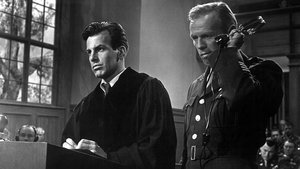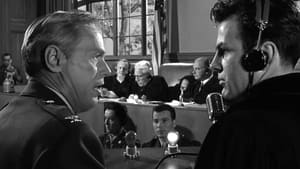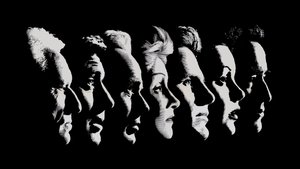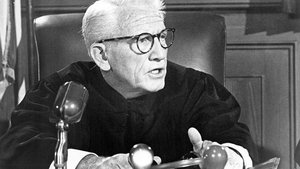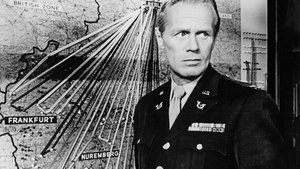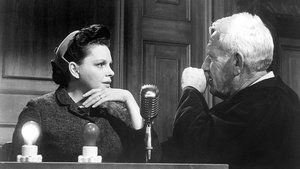Contact: info@alwanfilm.com
Video Sources 0 Views
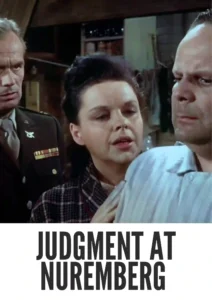
Synopsis
Review: Judgment at Nuremberg 1961 Colorized – An Exploration of Historical Justice and Moral Reckoning

Introduction
“Judgment at Nuremberg 1961,” directed by Stanley Kramer, stands as a monumental film in the landscape of historical dramas, capturing the complexities and moral dilemmas of post-World War II justice. This film, a profound exploration of the Nuremberg Trials, delves into the trials of Nazi judges who were accused of war crimes. The film is renowned not only for its historical portrayal but also for its deep examination of ethical and legal issues. In this article, we will explore the film’s significance, its historical context, and the impact it has had on both cinema and the broader discourse on justice and morality.
Check The Full Colorized Movies List
Check Our Colorized Movies Trailer Channel
Understanding Judgment at Nuremberg 1961 Colorized: Director, Cast, and Genre
Stanley Kramer, a director known for his socially conscious films, brings a unique vision to “Judgment at Nuremberg 1961.” Kramer’s reputation for tackling controversial and complex subjects is evident in this film, which is both a courtroom drama and a powerful commentary on the nature of justice and responsibility.
The film boasts an exceptional cast, including Spencer Tracy, who delivers a commanding performance as Judge Dan Haywood. Other notable actors include Burt Lancaster as Ernst Janning, Richard Widmark as Colonel Tad Lawson, and Judy Garland as Mrs. Bertholt. Each actor brings depth and nuance to their roles, contributing to the film’s powerful portrayal of the moral and legal questions surrounding the trials.
“Judgment at Nuremberg 1961” fits into the courtroom drama genre, but it also transcends this category by addressing broader themes of justice, responsibility, and the consequences of war. The film’s genre allows it to engage deeply with legal and ethical issues, making it a compelling study of human nature and the quest for justice.
Exploring the World of Judgment at Nuremberg 1961 Colorized: Plot and Characters
“Judgment at Nuremberg 1961” is set in the aftermath of World War II and focuses on the Nuremberg Trials, where prominent Nazi judges are put on trial for their roles in perpetuating the atrocities of the Holocaust. The film is framed around the trial of four judges accused of war crimes and crimes against humanity.
The plot revolves around Judge Dan Haywood, played by Spencer Tracy, who is tasked with overseeing the trial. As Haywood delves into the case, he is confronted with the complexities of human behavior, the nature of guilt, and the question of collective responsibility. The film’s narrative unfolds through a series of courtroom scenes, flashbacks, and character interactions, revealing the personal and political dimensions of the trial.
Key moments include the testimony of witnesses who describe the horrors inflicted by the Nazi regime, the defense arguments made by the accused judges, and Haywood’s own moral and legal dilemmas. The characters are richly developed, each representing different facets of the trial and its broader implications. Burt Lancaster’s portrayal of Ernst Janning, in particular, adds a layer of psychological complexity to the film, highlighting the conflict between personal responsibility and systemic complicity.
The Art of Historical Representation
“Judgment at Nuremberg 1961” is a masterful example of how cinema can address historical events with both accuracy and artistic sensitivity. The film’s representation of the Nuremberg Trials is grounded in historical reality, but it also uses artistic license to explore the deeper moral and philosophical questions raised by the trials.
The film’s attention to detail in depicting the courtroom procedures, the testimonies, and the characters’ emotional responses adds authenticity to its historical portrayal. However, it is the film’s ability to engage with the broader implications of the trial that makes it a significant contribution to both historical and cinematic discourse.
Early Historical Dramas: A Brief History
The genre of historical drama has long been a staple of cinema, offering audiences a window into significant events and figures from the past. Early historical dramas often focused on grand narratives and epic tales, but over time, the genre has evolved to include more nuanced and complex portrayals of historical events.
“Judgment at Nuremberg 1961” is part of this evolution, reflecting a shift towards more introspective and morally engaged historical dramas. The film’s exploration of the Nuremberg Trials represents a departure from traditional historical narratives, emphasizing the ethical and psychological dimensions of historical justice.
Judgment at Nuremberg 1961 Colorized and Its Historical Context
The decision to focus on the Nuremberg Trials in “Judgment at Nuremberg 1961” reflects the film’s commitment to addressing the moral and legal questions raised by the trials. The film’s portrayal of the trials is informed by historical research and interviews with key figures involved in the trials, providing a nuanced and accurate representation of the events.
The film’s historical context is also shaped by the broader political and social climate of the early 1960s. The Nuremberg Trials were a landmark moment in international law and justice, and the film’s exploration of these trials resonates with ongoing debates about accountability, responsibility, and the role of the judiciary in addressing war crimes.
The Debate Over Historical Accuracy and Artistic License
As with any historical film, “Judgment at Nuremberg 1961” has faced scrutiny regarding its accuracy and artistic interpretation. While the film strives to faithfully represent the events and themes of the Nuremberg Trials, it also takes creative liberties to enhance its dramatic impact.
The debate over historical accuracy versus artistic license highlights the challenges of adapting real events for cinematic storytelling. While some critics may argue that the film’s dramatization undermines its historical credibility, others contend that its exploration of moral and legal questions adds depth and relevance to its portrayal of the trials.
Examining Judgment at Nuremberg 1961 Colorized as a Historical Drama
Viewing “Judgment at Nuremberg 1961” as a historical drama offers insights into the film’s approach to depicting real events and characters. The film’s use of courtroom scenes, character interactions, and personal testimonies creates a compelling narrative that engages viewers with the complexities of justice and responsibility.
The film’s portrayal of the Nuremberg Trials is both respectful and thought-provoking, inviting viewers to consider the broader implications of the trial and its impact on international law. The historical accuracy of the film is complemented by its exploration of moral and philosophical questions, making it a valuable contribution to the genre of historical drama.
Influence and Legacy: Judgment at Nuremberg 1961 Colorized’s Impact on Cinema
“Judgment at Nuremberg 1961” has had a lasting impact on both cinema and the broader discourse on justice and morality. The film’s exploration of the Nuremberg Trials has inspired other works of historical drama and legal analysis, contributing to ongoing discussions about accountability and the nature of justice.
The film’s influence can be seen in subsequent courtroom dramas and historical films that grapple with similar themes of moral and legal responsibility. Its legacy extends beyond the realm of cinema, impacting public perceptions of historical justice and the role of the judiciary in addressing war crimes.
Director’s Cinematic Legacy: Beyond Judgment at Nuremberg 1961 Colorized
Stanley Kramer’s cinematic legacy extends beyond “Judgment at Nuremberg 1961,” encompassing a body of work that reflects his commitment to social issues and moral questions. Kramer is known for his films that address controversial and thought-provoking topics, including “Guess Who’s Coming to Dinner” and “On the Beach.”
Kramer’s work is characterized by its emphasis on social justice and ethical dilemmas, reflecting his belief in the power of cinema to address pressing societal issues. His films continue to be studied and admired for their bold exploration of complex themes and their impact on public discourse.
Themes Explored in Judgment at Nuremberg 1961 Colorized
“Judgment at Nuremberg 1961” explores a range of themes related to justice, responsibility, and the nature of human behavior. The film’s focus on the Nuremberg Trials highlights issues of moral and legal accountability, collective responsibility, and the consequences of war.
The film’s examination of these themes is both profound and challenging, inviting viewers to consider the complexities of justice and the moral implications of the trial. Through its portrayal of the trial and its characters, “Judgment at Nuremberg 1961” offers a thought-provoking exploration of the human condition and the quest for justice.
Reception and Controversy Surrounding Judgment at Nuremberg 1961 Colorized
The reception of “Judgment at Nuremberg 1961” has been marked by both acclaim and controversy. Critics have praised the film for its powerful performances, compelling narrative, and thought-provoking exploration of legal and moral issues. However, some have raised concerns about the film’s dramatization of historical events and its portrayal of the Nuremberg Trials.
The film’s impact on public discourse and its contribution to the genre of historical drama have been widely recognized, but it has also faced criticism for its creative liberties and its depiction of complex historical events. Despite these controversies, “Judgment at Nuremberg 1961” remains a significant and influential work in the realm of cinema.
Where to Watch Judgment at Nuremberg 1961 Colorized Online
For those interested in experiencing the profound drama of “Judgment at Nuremberg 1961,” the film is available on various streaming platforms and digital rental services. Its availability ensures that new audiences can engage with its powerful narrative and explore the complexities of justice and morality.
FAQs About Judgment at Nuremberg 1961 Colorized
Common queries about “Judgment at Nuremberg 1961” often revolve around its historical accuracy, its portrayal of key figures, and its thematic content. By addressing these frequently asked questions, viewers can gain a deeper understanding of the film’s significance and its place in cinematic and historical discourse.
Q: Is “Judgment at Nuremberg 1961” historically accurate?
A: While “Judgment at Nuremberg 1961” strives for historical accuracy in its portrayal of the Nuremberg Trials, it takeswood’s internal struggle as he grapples with the weight of his decision. The film also explores the impact of the trial on the lives of those involved, including the families of the accused and the survivors of the Holocaust.
The Art of Historical Drama
Historical dramas like “Judgment at Nuremberg 1961” play a crucial role in shaping our understanding of the past and its implications for the present. By recreating significant historical events and exploring the human stories behind them, these films offer valuable insights into the complexities of history and morality.
The art of historical drama involves meticulous research, attention to detail, and a commitment to authenticity. Filmmakers must balance the demands of dramatic storytelling with the need to respect historical accuracy, creating a narrative that is both engaging and informative. In “Judgment at Nuremberg 1961,” Stanley Kramer achieves this balance through a combination of powerful performances, a compelling script, and a thoughtful exploration of the moral questions at the heart of the Nuremberg Trials.
Early Reactions and Critical Reception
Upon its release, “Judgment at Nuremberg 1961” received widespread acclaim from critics and audiences alike. The film was praised for its powerful performances, particularly those of Spencer Tracy and Burt Lancaster, and for its thought-provoking exploration of complex legal and moral issues.
Critics lauded Kramer’s direction and the film’s ability to tackle challenging subjects with sensitivity and depth. The film was also noted for its strong screenplay, which effectively conveyed the gravity of the Nuremberg Trials and the broader implications for justice and accountability.
Despite its acclaim, “Judgment at Nuremberg 1961” also faced criticism from some quarters, with critics arguing that the film’s portrayal of the trials was overly dramatic and simplified complex historical events. Nonetheless, the film’s impact on public discourse and its contribution to the genre of historical drama remain significant.
The Legacy of Judgment at Nuremberg 1961
“Judgment at Nuremberg 1961” has left a lasting legacy in the realm of historical cinema and legal drama. The film’s exploration of justice, morality, and responsibility continues to resonate with audiences and scholars, serving as a powerful reminder of the importance of accountability in the aftermath of war.
The film has influenced subsequent portrayals of historical trials and legal dramas, setting a high standard for storytelling and performance in the genre. Its impact can be seen in later works that address similar themes, such as “The Caine Mutiny” and “A Few Good Men,” which explore the complexities of military and legal justice.
Director’s Cinematic Legacy: Beyond Judgment at Nuremberg 1961
Stanley Kramer’s directorial legacy extends beyond “Judgment at Nuremberg 1961,” encompassing a diverse body of work that reflects his commitment to social issues and human rights. Kramer’s films often tackle controversial subjects, including racism, inequality, and political corruption, and are characterized by their strong moral messages and commitment to social justice.
Other notable films by Kramer include “Guess Who’s Coming to Dinner,” which addresses issues of race and interracial marriage, and “The Defiant Ones,” which explores themes of racial segregation and redemption. Kramer’s body of work continues to be celebrated for its bold storytelling and its impact on social and political discourse.
Themes Explored in Judgment at Nuremberg 1961
“Judgment at Nuremberg 1961” delves into several profound themes, including the nature of justice, the concept of moral responsibility, and the impact of war on individuals and societies. The film’s exploration of these themes is central to its narrative and contributes to its powerful and thought-provoking nature.
One of the key themes of the film is the question of collective guilt and individual responsibility. Through the trial of the Nazi judges, the film examines the extent to which individuals can be held accountable for their actions within a larger system of oppression. It challenges viewers to consider the complexities of moral responsibility and the consequences of complicity.
Another important theme is the struggle between justice and mercy. The film explores the tension between the need for retribution and the desire for understanding and forgiveness, highlighting the challenges of reconciling legal principles with human compassion.
Reception and Controversy Surrounding Judgment at Nuremberg 1961
“Judgment at Nuremberg 1961” has been both praised and critiqued for its portrayal of historical events and its exploration of legal and moral issues. The film’s strong performances and thought-provoking themes have been widely acclaimed, but some critics have questioned the accuracy of its representation of the Nuremberg Trials and the simplicity of its moral conclusions.
The film’s reception reflects broader debates about the role of historical drama in shaping our understanding of the past and the responsibilities of filmmakers to present historical events with fidelity and nuance. Despite these debates, “Judgment at Nuremberg 1961” remains an influential and significant work, recognized for its contributions to the genre and its impact on public discourse.
Where to Watch Judgment at Nuremberg 1961 Online
For those interested in experiencing “Judgment at Nuremberg 1961,” the film is available on various streaming platforms and can be found in digital and physical formats. Its availability ensures that new generations of viewers can engage with its powerful storytelling and thought-provoking themes.
FAQs About Judgment at Nuremberg 1961
Common queries about “Judgment at Nuremberg 1961” often revolve around its historical accuracy, the portrayal of key figures, and the impact of its themes. Addressing these frequently asked questions can provide valuable insights into the film’s significance and its place in cinematic history.
Q: Is “Judgment at Nuremberg 1961” historically accurate?
A: While “Judgment at Nuremberg 1961” is based on the real-life Nuremberg Trials, it takes artistic liberties to dramatize and simplify certain aspects of the historical events. The film aims to capture the essence of the trials and the moral questions they raised, rather than providing a strict historical account.
Q: What is the significance of the film’s title?
A: The title “Judgment at Nuremberg” refers to the location of the trials and the central theme of the film, which is the judgment of Nazi judges for their roles in war crimes. The title underscores the film’s focus on legal and moral reckoning in the aftermath of World War II.
Q: How has the film influenced subsequent portrayals of historical trials?
A: “Judgment at Nuremberg 1961” has set a high standard for the portrayal of historical trials and legal dramas. Its impact can be seen in later films that address similar themes, such as “The Caine Mutiny” and “A Few Good Men,” which continue to explore issues of justice and accountability.
Conclusion
“Judgment at Nuremberg 1961” stands as a monumental achievement in historical cinema, offering a powerful exploration of justice, morality, and the consequences of war. Stanley Kramer’s direction, coupled with an exceptional cast, brings to life the complexities of the Nuremberg Trials and the profound moral questions they raised.
While the film’s portrayal of historical events may be simplified for dramatic effect, its impact on public discourse and its contribution to the genre of historical drama are undeniable. As we continue to grapple with issues of justice and accountability in the modern world, “Judgment at Nuremberg 1961” serves as a poignant reminder of the enduring importance of moral and legal reckoning. Its legacy continues to inspire and challenge viewers, ensuring that its message remains relevant and impactful for generations to come.
